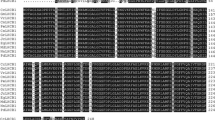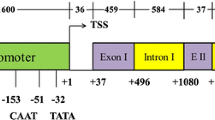Abstract
We report here the isolation and nucleotide sequence of tomato cDNA and genomic clones encoding a ubiquitin extension protein homologous to the yeast gene ubi3. Sites similar to upstream activating sites commonly found in the promoters of yeast ribosomal genes were observed in the tomato promoter. The tomato ubi3 promoter also contained elements found in the rbcS promoter from pea. The transcription initiation site was determined to occur 66 bp upstream of the initiating Met. RFLP mapping revealed that the gene was located on chromosome 1, 23 cM from marker TG301. A ubi3 gene-specific probe hybridized to a single 800 nt transcript. Expression was reduced in heat-shocked plants and plants kept in the dark. Expression was highest in young leaves and immature green fruit and lowest in mature leaves and petals. We isolated the original cDNA clone using an antibody prepared against chloroplast polypeptides. Immunological studies did not detect ubiquitin or ubiquitin extension proteins in the chloroplast. However, higher-molecular-weight chloroplast proteins were detected with ubiquitin antisera suggesting that ubiquitin conjugates are transported into the chloroplast.
Similar content being viewed by others
References
Bernatzky R, Tanksley SD: Toward a saturated linkage map in tomato based on isozymes and random cDNA sequences. Genetics 112: 887–898 (1986).
Burke TJ, Callis J, Vierstra RD: Characterization of a polyubiquitin gene from Arabidopsis thaliana. Mol Gen Genet 213: 435–443 (1988).
Callis J, Pollmann L, Shanklin J, Wettern M, Vierstra RD: Sequence of a cDNA from Chlamydomonas reinhardii encoding a ubiquitin-52 amino acid extension protein. Nucl Acids Res 17: 8377 (1989).
Callis J, Raasch JA, Vierstra RD: Ubiquitin extension proteins of Arabidopsis thaliana — Structure, localization, and expression of their promoters in transgenic tobacco. J Biol Chem 265: 12486–12493 (1990).
Cashmore AR: The isolation of poly A+ messenger RNA from higher plants. In: Edelman M, Hallick RB, Chua N-H (eds) Methods in Chloroplast Molecular Biology, pp. 387–392. Elsevier Biomedical Press, Amsterdam (1982).
Chau V, Tobias JW, Bachmair A, Marriott D, Ecker DJ, Gonda DK, Varshavsky A: A multiubiquitin chain is confined to specific lysine in a targeted short-lived protein. Science 243: 1576–1583 (1989).
Cheng MY, Hartl F-U, Martin J, Pollack RA, Kalousek F, Neupert W, Hallberg E, Hallberg R, Horwich AL: Mitochondrial heat-shock protein hsp60 is essential for assembly of proteins imported into yeast mitochondria. Nature 337: 620–625 (1989).
Datta N, Cashmore AR: Binding of a pea nuclear protein to promoters of certain photoregulated genes is modulated by phosphorylation. Plant Cell 1: 1069–1077 (1989).
Finley D, Bartel B, Varshavsky A: The tails of ubiquitin precursors are ribosomal proteins whose fusion to ubiquitin facilitates ribosome biogenesis. Nature 338: 394–401 (1989).
Finley D, Ozkaynak E, Jentsch S, McGrath JP, Bartel B, Pazin M, Snapka RM, Varshavsky A: Molecular genetics of the ubiquitin system. In: Rechsteiner M (ed) Ubiquitin, pp. 39–75. Plenum Press, New York/London (1988).
Gausing K, Barkardottir R: Structure and expression of ubiquitin genes in higher plants. Eur J Biochem 158: 57–62 (1986).
Gausing K, Jensen CB: 2 Ubiquitin long-tail fusion genes arranged as closely spaced direct repeats in barley. Gene 94: 165–171 (1990).
Genschik P, Parmentier Y, Criqui MC, Fleck J: Sequence of a ubiquitin carboxyl extension protein of Nicotiana tabacum. Nucl Acids Res 18: 4007 (1990).
Giuliano G, Pichersky E, Malik VS, Timko MP, Scolnick PA, Cashmore AR: An evolutionarily conserved protein binding sequence upstream of a plant light-regulated gene. Proc Natl Acad Sci USA 85: 7089–7093 (1988).
Goff SA, Voellmy R, Goldberg AL: Protein breakdown and the heat shock response. In: Rechsteiner M (eds) Ubiquitin, pp. 207–238. Plenum Press, New York/London (1988).
Green PJ, Young M-H, Cuozzo M, Kano-Murakami Y, Silverstein P, Chua N-H: Binding site requirements for pea nuclear protein factor GT-1 correlate with sequences required for light-dependent transcriptional activation of the rbcS-3A gene. EMBO J 7: 4035–4044 (1988).
Hoffman NE, Pichersky E, Malik VS, Castresana C, Ko K, Darr SC, Cashmore AR: A cDNA clone encoding a photosystem I protein with homology to photosystem II chlorophyll a/b-binding polypeptides. Proc Natl Acad Sci USA 84: 8844–8848 (1987).
Kellmann JW, Pichersky E, Piechulla B: Analysis of the diurnal expression patterns of the tomato chlorophyll a/b-binding protein genes — Influence of light and characterization of the gene family. Photochem Photobiol 52: 35–41 (1990).
Kuhlemeier C, Cuozzo M, Green PJ, Goyvaerts E, Ward K, Chua N-H: Localization and conditional redundancy of regulatory elements in rbcS-3A, a pea gene encoding the small subunit of ribulose-bisphosphate carboxylase. Proc Natl Acad Sci USA 85: 4662–4666 (1988).
Lee H, Simon J, Lis JT: Structure and expression of ubiquitin genes of Drosophila melanogaster. Mol Cell Biol 8: 4727–4735 (1988).
Lund PK, Moats-Staats BM, Simmons JG, Hoyt E, D'Ercole AJ, Martin F, VanWyk JJ: Nucleotide sequence analysis of a cDNA encoding human ubiquitin reveals that ubiquitin is synthesized as a precursor. J Biol Chem 260: 7609–7613 (1985).
Maniatis T, Fritsch EF, Sambrook J: Molecular Cloning: A Laboratory Manual. Cold Spring Harbor Laboratory, Cold Spring Harbor, NY (1982).
Mullertaubenberger A, Graack HR, Grohmann L, Schleicher M, Gerisch G: An extended ubiquitin of Dictyostelium is located in the small ribosomal subunit. J Biol Chem 264: 5319–5322 (1989).
Mullet JE, Burk JJ, Arntzen CJ: Chlorophyll proteins of Photosystem I. Plant Physiol 65: 814–822 (1980).
Ostermann J, Horwich AL, Neupert W, Hartl FU: Protein folding in mitochondria requires complex formation with Hsp60 and ATP hydrolysis. Nature 341: 125–130 (1989).
Ozkaynak E, Finley D, Solomon MJ, Varshavsky A: The yeast ubiquitin genes: a family of natural gene fusions. EMBO J 6: 1429–1439 (1987).
Pichersky E, Hoffman NE, Malik VS, Bernatzky R, Tanksley SD, Szabo L, Cashmore AR: The tomato cab-4 and cab-5 genes encode a second type of CAB polypeptides localized in photosystem II. Plant Mol Biol 9: 109–120 (1987).
Planta RJ, Raue HA: Control of ribosome biogenesis in yeast. Trends Genet 4: 64–68 (1988).
Reading DS, Hallberg RL, Myers AM: Characterization of the yeast HSP60 gene coding for a mitochondrial assembly factor. Nature 337: 655–659 (1989).
Redman KL, Rechsteiner M: Identification of the long ubiquitin extension as ribosomal protein S27a. Nature 338: 438–440 (1989).
Sanger F, Nicklen S, Coulson AR: DNA sequencing with chain terminating inhibitors. Proc Natl Acad Sci USA 74: 5463–5467 (1977).
Shanklin J, Jabben M, Vierstra RD: Red light formation of ubiquitin-phytochrome conjugates: identification of possible intermediates of phytochrome degradation. Proc Natl Acad Sci USA 84: 359–363 (1987).
St. John T, Gallatin M, Siegelman M, Smith HT, Fried VA, Weissman IL: Expression cloning of a lymphocyte homing receptor cDNA: Ubiquitin is the reactive species. Science 231: 845–850 (1986).
Sugita M, Manzara T, Pichersky E, Cashmore A, Gruissem W: The genomic organization, sequence analysis, and expression of all five genes encoding the small subunit of ribulose 1,5-bisphosphate carboxylase from tomato. Mol Gen Genet 209: 247–256 (1987).
Veierskov B, Ferguson IB: Conjugation of ubiquitin to proteins from green plant tissues. Plant Physiol 96: 4–9 (1991).
Wettern M, Parag HA, Pollmann L, Ohad I, Kulka RG: Ubiquitin in Chlamydomonas reinhardtii — Distribution in the cell and effect of heat shock and photoinhibition on its conjugate pattern. Eur J Biochem 191: 571–576 (1990).
Zhaung Z, McCauley R: Ubiquitin is involved in the in vitro insertion of monamine oxidase B into mitochondrial outer membranes. J Biol Chem 264: 14594–14596 (1989).
Author information
Authors and Affiliations
Rights and permissions
About this article
Cite this article
Hoffman, N.E., Ko, K., Milkowski, D. et al. Isolation and characterization of tomato cDNA and genomic clones encoding the ubiquitin gene ubi3 . Plant Mol Biol 17, 1189–1201 (1991). https://doi.org/10.1007/BF00028735
Received:
Accepted:
Issue Date:
DOI: https://doi.org/10.1007/BF00028735




